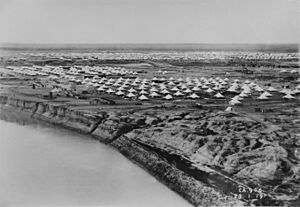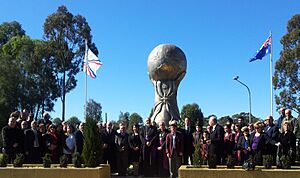Sayfo facts for kids
The Sayfo (which means "sword" in the Assyrian language) is also known as the Assyrian genocide. It was a terrible time during World War I when many Assyrian and Syriac Christians were killed or forced to leave their homes. This happened in areas like southeastern Anatolia (part of modern-day Turkey) and the Azerbaijan province of Persia (modern-day Iran). The attacks were carried out by the Ottoman army and some Kurdish tribes.
Contents
What Happened During the Sayfo?
Before World War I, Assyrians lived in different groups, often in mountains and remote areas of the Ottoman Empire. They belonged to various Christian churches, like the Syriac Orthodox Church and the Chaldean Catholic Church. During the 1800s, the Ottoman Empire tried to gain more control over these areas, which led to more danger for the Assyrians.
Attacks Begin in Persia and Bitlis
Mass killings of Assyrian civilians started when the Ottoman army occupied parts of Persia from January to May 1915. During this time, Ottoman soldiers and Kurdish groups who supported them committed massacres. In the Bitlis area, Ottoman troops returning from Persia joined local Kurdish tribes. Together, they killed Christians, including both Armenians and Assyrians.
Hakkari and Diyarbekir Provinces Attacked
In mid-1915, Ottoman forces and Kurds attacked Assyrian tribes in the Hakkari region. Even though the tribes fought back, they were forced to leave their homes by September.
In the Diyarbekir province, a governor named Mehmed Reshid ordered the killing of all Christian communities, including Syriac Christians. There was some fighting back in certain parts of Tur Abdin, but many were still killed. However, Assyrians living further south, in what is now Iraq and Syria, were not targeted in these killings.
Why Did This Happen?
The Sayfo happened at the same time as the Armenian genocide and was connected to it. However, the Sayfo was less organized. Local groups played a bigger role in the killings, but the Ottoman government also ordered attacks on some Assyrians. People were killed because some Assyrian communities were seen as disloyal to the Ottoman Empire. Also, some wanted to take over their land.
How Many People Died?
At the Paris Peace Conference in 1919, Assyrian representatives said that about 250,000 Assyrians had died. This was about half of their population before the war. Later, at the Lausanne Conference in 1923, they changed their estimate to 275,000 deaths. It's hard to know the exact number, but many lives were lost.
The Sayfo is not as well-known as the Armenian genocide. Efforts to have it officially recognized as a genocide began in the 1990s, led by Assyrians living outside their homeland. Several countries now agree that Assyrians were victims of a genocide. However, the Turkish government does not accept this.
Understanding the Names
The word Suryoyo is what Assyrians call themselves. There are different ways to translate it into English, like Assyrian, Syriac, Aramean, and Chaldean. The name people choose often depends on their political views.
The Ottoman Empire used to organize people by their religion, not their ethnic group. So, back then, officials would refer to people by their church.
In the Assyrian language (Neo-Aramaic), this event has been called Sayfo or Seyfo since 1915. This word means "sword," but it can also mean "extermination" or "extinction." Some Assyrians also use words like nakba (Arabic for 'catastrophe') or firman (Turkish for 'order'), because they believed the killings were ordered by the government.
Life After the Sayfo
Exile in Iraq
As Assyrians fled, many were attacked by Kurdish groups and some died from exhaustion. Thousands were killed near Heydarabad and during an ambush near the Sahin Ghal'e mountain pass.
Many Assyrians depended on the British for safety. They were moved to a refugee camp in Baqubah (near Baghdad) in October 1918. This camp held about 15,000 Armenians and 35,000 Assyrians. Conditions were very bad, and about 7,000 Assyrians died there. The British wanted the Assyrians to return home, but the Persian government said no.
In 1920, the Baqubah camp closed. Assyrians hoping to go back to Azerbaijan or Hakkari were sent north to Midan. About 4,500 Assyrians were settled near Duhok and Akre in northern Iraq. They worked as soldiers for the British rulers of Mandatory Iraq. However, the British did not keep their promises to resettle Assyrians in safer areas.
After the British rule ended, Assyrians faced more violence, like the 1933 Simele massacre. After this, France allowed 24,000 to 25,000 Assyrians to move to the Khabur region in northeastern Syria. Other Assyrians went to places like the Caucasus, Russia, or Lebanon. A few also moved to the United States, Canada, and Europe.
Assyrians in Turkey
A few thousand Assyrians stayed in Hakkari after 1915, and some returned after the war. In 1920, an Assyrian leader named Agha Petros tried to lead a group back to their homes, but they were stopped by a Kurdish leader and the Turkish army. The remaining Assyrians were forced out again in 1924 by the Turkish army. This left the mountains empty of people.
In Siirt, some Syriac people who had converted to Islam (mostly women) stayed behind. Their families, who now speak Kurdish or Arabic, still live there.
The survivors lost their land and became farm workers or poor city dwellers. Kurdish or Muslim people from the Caucasus moved into the empty Christian villages. During and after the Sayfo, more than 150 churches and monasteries were destroyed. Others were turned into mosques or used for other purposes. Many old books and cultural items were also lost.
After 1923, local politicians started a campaign against Christians. This affected Syriac communities in places like Adana and Urfa that had not been hit by the 1915 genocide. Many were forced to leave their homes and flee to Syria, settling in cities like Aleppo or the Khabur region.
The Syriac Orthodox patriarchate (their religious leader) was forced to leave Turkey in 1924. This happened even though they tried to get along with Turkish nationalists. Unlike Armenians, Jews, and Greeks, Assyrians were not recognized as a minority group in the 1923 Treaty of Lausanne.
The Assyrians who remained in Turkey lived under the control of Kurdish leaders. They faced harassment and abuse, which made many of them leave the country. Turkish laws took away the citizenship and property of those who had fled. Even with citizenship rights, many Assyrians in Turkey had to buy back their own property from Kurdish leaders or risk losing their Turkish citizenship. Many Assyrians continued to live in Tur Abdin until the 1980s. Some experts say that the ongoing exclusion and harassment of Assyrians in Turkey is a continuation of the Sayfo.
Paris Peace Conference
In 1919, Assyrians went to the Paris Peace Conference. They wanted to ask for money to make up for what they had lost during the war. Many of them asked for money and an independent country. They all stressed that Assyrians could not live under Muslim rule. The land they claimed included parts of modern-day Turkey, Iraq, and Iran.
Even though people felt sympathy for the Assyrians, none of their demands were met. The British and French had other plans for the Middle East. Also, the growing Turkish nationalist movement was a problem. Assyrians remembered that the British had promised them an independent country if they helped in the war. Many Assyrians felt betrayed when this promise was not kept.
How Many Died?
Assyrian representatives at the Paris Peace Conference said that 250,000 Assyrians died in the Ottoman Empire and Persia. This was about half of their population before the war. In 1923, at the Lausanne Conference, they increased their estimate to 275,000. We don't know where these numbers came from, and it's hard to check if they are exact. The Assyrian representatives might have made the numbers higher to get more attention.
While more than 50 percent of the population was killed in some areas, Assyrian communities in what is now Syria and Iraq were mostly unharmed. The Sayfo was not as organized as the Armenian genocide. In some places, all Christians were killed, but in others, local officials spared Assyrians and only targeted Armenians.
| Region | Losses | Notes |
|---|---|---|
| Persia | 40,000 | This number might be too high. One German observer estimated that 21,000 Christians were killed in Azerbaijan between December 1914 and February 1915. |
| Van (including Hakkari) | 80,000 | This is a very high number and should be looked at carefully. A Russian official estimated that 45,000 Assyrians from Hakkari fled to Persia, out of more than 70,000 people who lived there before the war. |
| Diyarbekir | 63,000 | A Catholic priest estimated that over 74,000 Syriac Orthodox, Chaldeans, Syriac Catholics, and Protestants were killed out of 144,185 total Christian deaths in Diyarbekir. |
| Harput | 15,000 | Some historians say Assyrians were not forced to leave Harput. The Armenian genocide in Harput became a Christian one. |
| Bitlis | 38,000 | A priest estimated that before the war, 60,000 Christians lived in the Siirt district (including 15,000 Chaldeans and 20,000 Syriac Orthodox). The Syriac Orthodox Church estimated its losses at 8,500 in the province. |
| Adana, Der Zor and elsewhere | 5,000 | Some historians say the Assyrian population in Adana was not affected by the Sayfo. |
| Urfa | 9,000 | Some historians also say the Assyrian population in Urfa was not affected by the Sayfo. |
| Total | 250,000 | — |
Remembering the Sayfo
For Assyrians, the Sayfo is seen as the worst example of how they have been treated badly in modern times. Stories of the genocide were usually told by word of mouth, not written down. Memories were often shared through sad songs. After many Assyrians moved to Western countries (where they had more freedom to speak) in the second half of the 1900s, the grandchildren of survivors started sharing these stories more openly.
International Recognition
The Sayfo is not as well-known as the Armenian genocide. This is partly because the victims were divided among different churches and did not have one single identity. In the 1990s, before much academic research was done, Assyrian groups living abroad started pushing for the Sayfo to be officially recognized, just like the Armenian genocide.
In December 2007, the International Association of Genocide Scholars passed a resolution recognizing the Assyrian genocide. The Sayfo is also recognized as a genocide by Sweden (in 2010), Armenia (2015), the Netherlands (2015), and Germany (in 2016). There are memorials in Armenia, Australia, Belgium, France, Greece, Sweden, Ukraine, and the United States to remember the victims of the Sayfo.
Denial and Justification
The Turkish government denies that the Sayfo was a genocide. Unlike its denial of the Armenian genocide, it usually tries to avoid talking about the Sayfo.
Images for kids
-
A Syriac Orthodox family in Mardin in 1904.


















